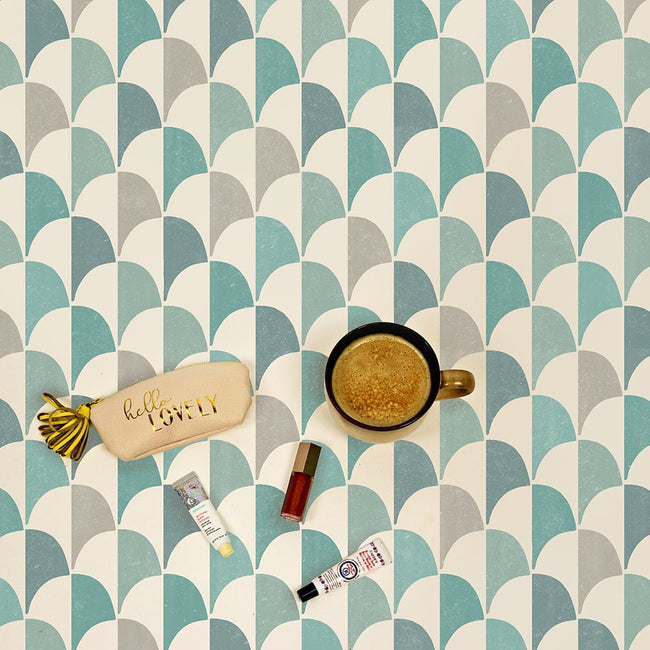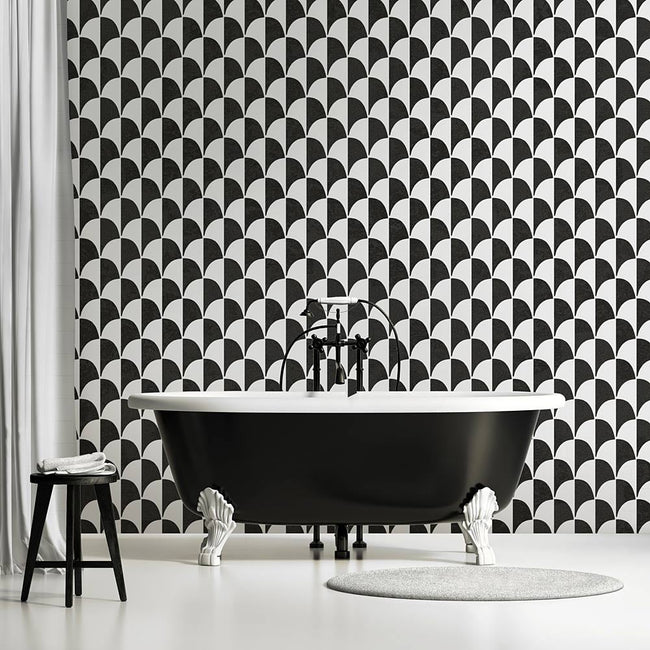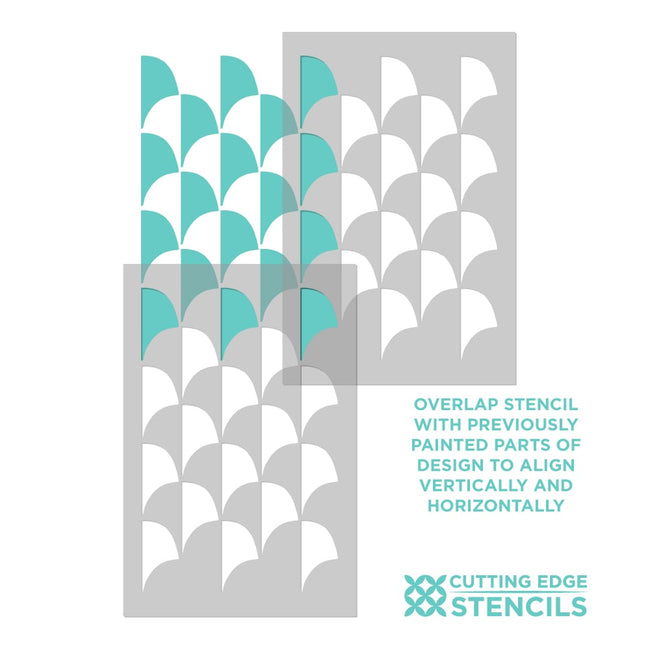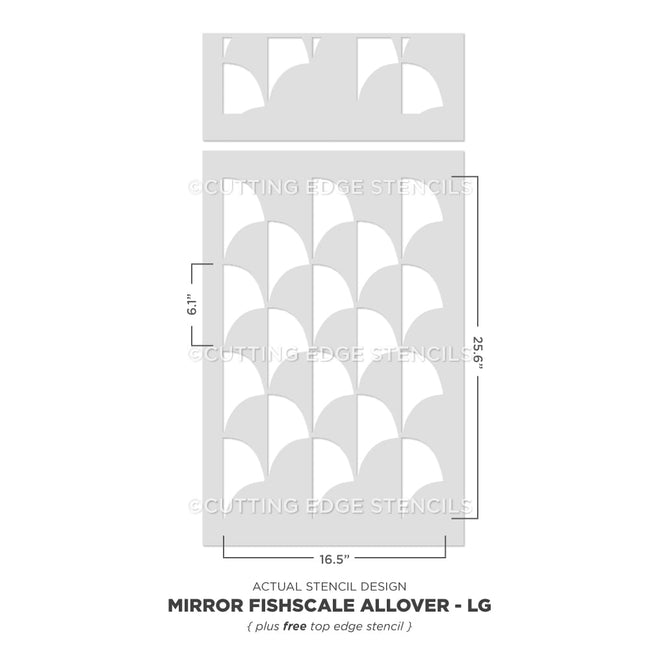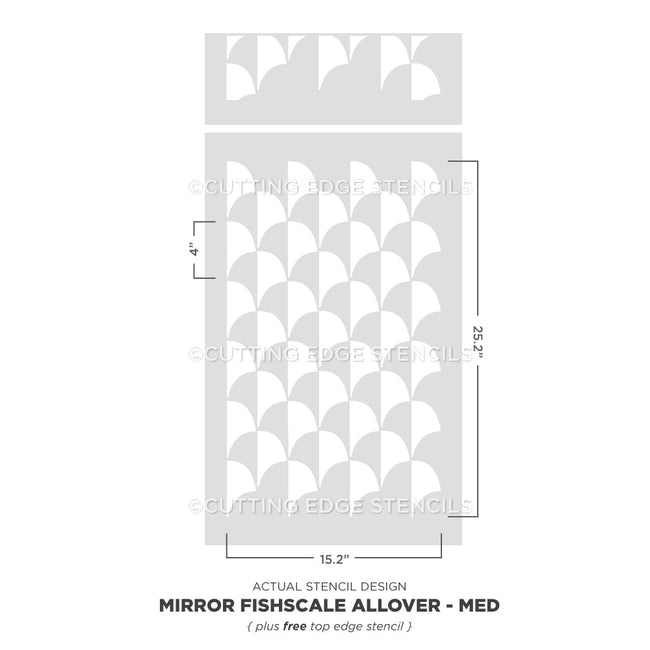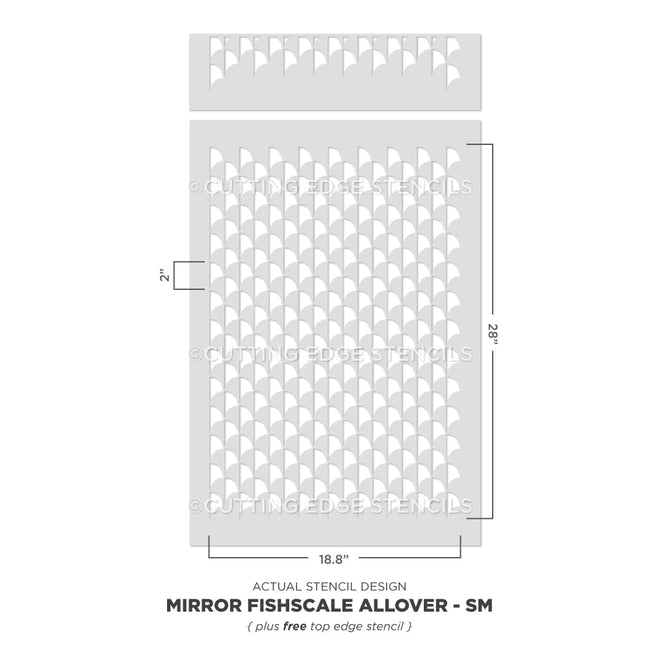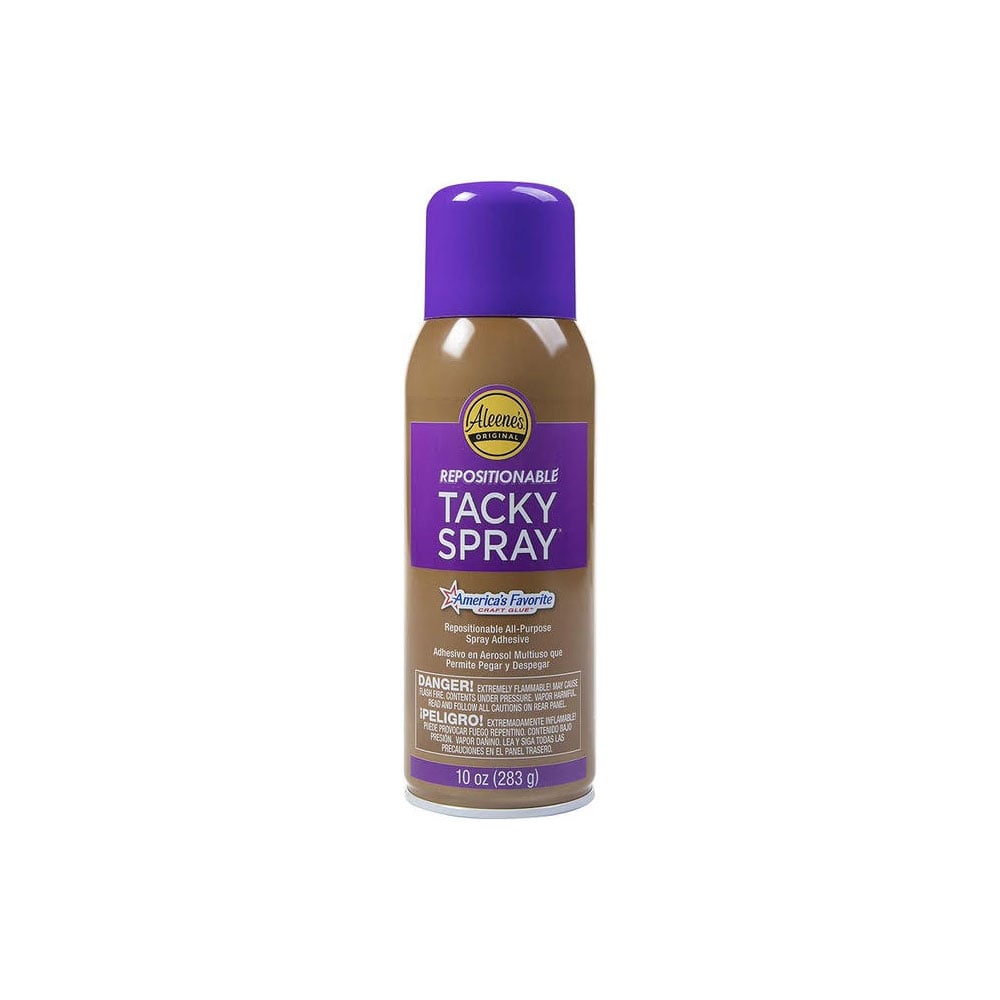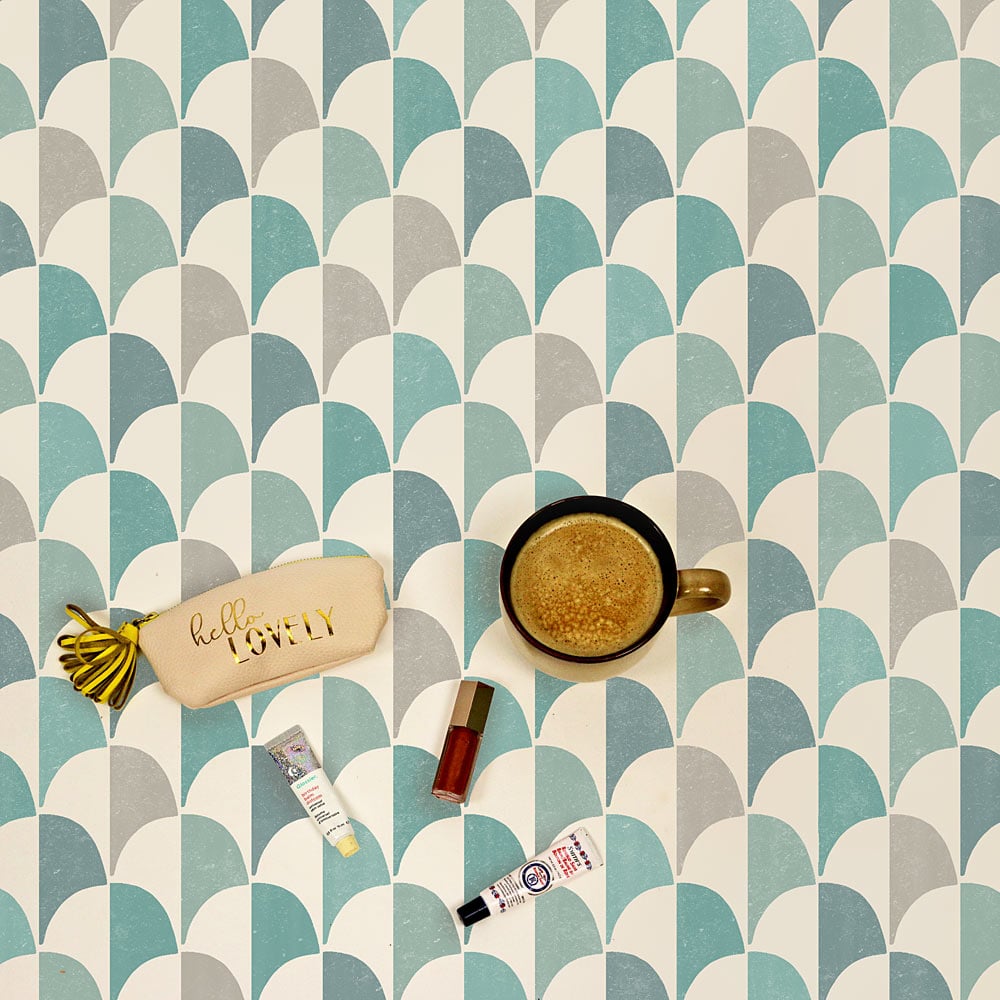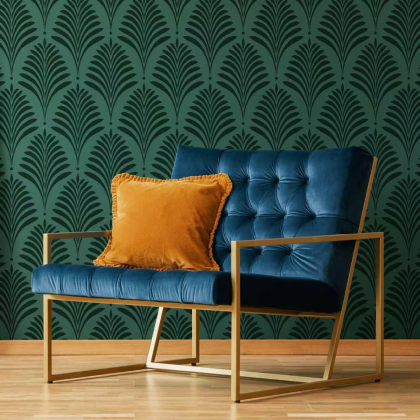Mirror Fishscale Tile Stencil Pattern
Choose options
Fishscale tile patterns are back in style! This beautiful Moroccan inspired scallop tile stencil looks stunning on an accent wall, on a painted backsplash or as a tile floor. The dramatic mirror effect of this Mirror Fishscale Stencil pattern makes it a real show-stopper. Our tile stencils are the perfect money saving alternative to real scallop tiles. This mermaid tile pattern looks great on a bathroom wall, or as a trendy painted tile floor. Learn How to stencil a tile floor - it’s so easy!
Stencil features an easy registration system, just use parts of the previously painted design to align the stencil, check for level and continue. This gives you a seamless "wallpaper" look. Don't worry about super perfect alignment: in the end your eye will never ever notice the discrepancy.
While prior stenciling experience is a plus for allover stencil patterns, even beginners get great results!
Try this stencil with our new Clip-On Stencil Level, (sold separately) and discover how easy it is to achieve perfectly level results without dealing with all those bulky heavy bubble levels and annoying laser levels.
Want to learn how to stencil a damask or allover pattern? Here are the detailed illustrated step-by-step Damask/Allover Stenciling Tips.
And make sure you watch our short step-by-step Video Tutorials! You'll find them extremely helpful for your stenciling project.
Although our stencils do not require the use of spray adhesive, this stencil could benefit from it to help minimize paint seepage, especially if your walls have a slight texture to them. (Elmer's spray adhesive seems to be the best). Make sure you shake the can well and lightly mist (not drench) the stencil, and let it dry for a moment before positioning it on the wall. This step will prevent the adhesive residue transferring to the wall. You'll need to re-mist the stencil after a few repeats. Note: you will still need to hold the stencil in place with a few pieces of blue painters tape! Adhesive by itself is not enough to hold the stencil on the wall. Clean-up tip: Spray the stencil with Simple Green to help to remove adhesive residue. Please note that once you've used spray adhesive on your stencil, it will never really come off completely. That is why we personally prefer not to use adhesive, and instead use less paint on your roller or stencil brush.
About seepage and imperfections: Even with a proper loaded roller and correct technique you might get some minor paint seepage here and there. In most cases it's not noticeable, especially from a couple of feet away and it can be easily touched up with a small brush. Don't forget that you're creating a "hand-painted wall finish". A few imperfections and some paint seepage here and there are natural and inevitable for this type of work. To avoid seepage, use spray adhesive and less paint on your roller and brush.
Did you know you can stencil your own fabric and use it for curtains, tablecloths, pillows, etc.? When stenciling on fabric, please use stencil adhesive to ensure good results. First, tape your ironed fabric to the surface so it doesn't move around while you stencil. You'll get better results with stencil brushes, but sometimes roller can work too, depending on your fabric. Add some textile medium ( sold in craft stores) to your acrylic paint. You can also get a specially formulated fabric paint, but, frankly, good craft acrylic paint with a dollop of textile medium mixed in works just as well, and costs way less! :) Let the stenciled image dry completely, 24 hours is best, then heat-set it by ironing the fabric for about 20-30 seconds on a LOW setting through the piece of cloth. Heat-setting will cure the paint and will prevent it from being washed off in the washing machine. Always experiment with a sample of your fabric first to ensure good results. We have stenciled on silk, cotton, linen and even sheer fabrics with great results. It's always better if your fabric doesn't have too much texture.
Our stencils are made to last and with proper care and storage will serve you for long time.
- Our stencils are expertly designed by decorative painting professionals Janna Makaeva and Greg Swisher, so when you're buying a stencil from Cutting Edge it's backed by our 20+ years of painting and decorating experience.
- Our Sturdy and Reusable stencils can be used again and again. One stencil can produce many images unlike one-time use vinyl decals. Our stencils are laser cut from top quality 10 mil mylar stencil material which is user-friendly and easy to clean.
- If you compare our stencil thickness, size, design quality, prices and the level of customer support, you will be amazed at the value that Cutting Edge Stencils offers!
- Stencils are super economical! Stenciling is more cost effective than wallpaper, decals or faux finishes. Stencils work on walls, even lightly textured ones, also on floors, ceilings, furniture and fabric You are not limited with your color choices. Choose any paint color you want to perfectly match your decor Stencils will never damage your walls. No peeling, no glue residue, no worries.
- Unlike decals or wallpaper, stenciling is easy to touch-up, adjust or re-do. With most decals you only get one chance to install it right. With wallpaper, the splitting seams and messy removal together with high cost makes it a less attractive option.
- We ship our stencils fast using USPS Priority Mail and also offer Expedited shipping options and International shipping at very competitive rates.
- Our large stencil collection is constantly growing reflecting the most current decorating trends, so you have plenty of modern stencil designs to choose from.
- We offer custom scaling of our designs up or down to accommodate your specific project.
- Our customer service is the best and the friendliest! We are here for you to answer your questions, to help you place an order, and to solve any possible issues.
- Cutting Edge Stencils is an established leading brand with a huge social following, actively present on all major social platforms. We offer the best in the industry video tutorials and expert stenciling instructions.
USPS can deliver most domestic packages within 3-5 business days (often sooner). For international packages, the delivery time is appr. 7-14 days. For Expedited shipping please select the options at the Checkout. Allow 1 business day for processing of all expedited orders.
30-DAY RETURNS
You can return your unused items within 30 days with no restocking fee. Questions? Please see our full Shipping and Returns Policy.
If you require custom size stencils, please contact us.


